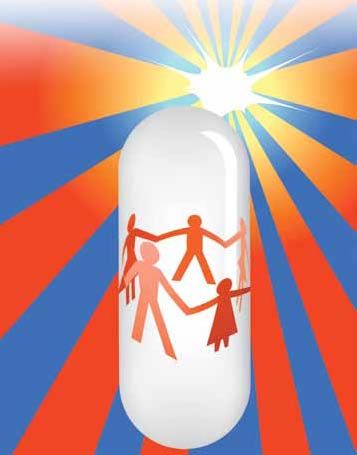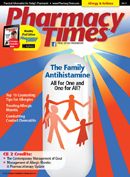Publication
Article
Pharmacy Times
The Family Antihistamine: All for One and One for All?
Author(s):
The choice of which antihistamine to use for allergy symptoms is often a family affair. Pharmacists can help patients move from a panacea model to one that takes into account individual needs and medical history.
The choice of which antihistamine to use for allergy symptoms is often a family affair. Pharmacists can help patients move from a panacea model to one that takes into account individual needs and medical history.

In the movie “My Big Fat Greek Wedding,” Toula’s Windex-wielding father attempts to cure everything “from psoriasis to poison ivy” with this caustic spray. Most families have a small collection of panaceas—sometimes based on family folklore or discovered serendipitously when they used the product for one indication and found it “fixed” something else. It shouldn’t surprise us that families have inclinations toward specific antihistamines, but a number of pharmacists have noted (often with silly little grins on their faces) that in some families, there’s a loyal preference for a certain product that promises relief from hay fever and allergies.
For these families, antihistamine use is a bonding experience. They share their personal supply of their drug of choice when a parent runs out or a sibling leaves his supply in his locker at the gym. They pass a package around at breakfast as if they were passing the salt shaker, commiserating about the pollen count or the recent onset of stuffiness or congestion. And they actually diagnose one another’s often off-label symptoms as allergy related or antihistamine treatable. Headache? Probably allergy related. Red skin? That’s a histamine reaction!
One aspiring family matriarch, for example, insisted her elderly mother take a second-generation antihistamine at bedtime during a vacation on which they shared a room. Why? Because grandma was a legendary snorer, a problem the aspiring matriarch attributed to allergies. This type of pseudoscientific action on the aspiring matriarch’s part has the entire clan rolling their eyes when she suggests an antihistamine for any symptom beyond itchy eyes, sneezing, itching, or a runny nose.
Surprise or No Surprise?
Maybe family affinity for specific antihistamines shouldn’t surprise us. Allergies, after all, have a genetic component, so it is not surprising that people who are related share the same or similar patterns of maladaptive immunological reactivity when exposed to allergens. 1-4 Additionally, families who live and eat together face the same environmental challenges—dust, mites, chemicals, fragrances, and foods, to mention a few. And, family members whose joint mission is to make the misery of allergies disappear often want the same things—one family group said they want to feel better without getting all “dopey” or sleepy. They often discuss specific symptoms using a vernacular unique to their group. In other words, one family’s mucus is another family’s “gunk.”
Families reach for relief when symptoms cross thresholds that researchers have probably not used or even considered. Once such threshold—the parents’ patience level—might be crossed when kids wipe their noses on their sleeves one time too many, or a sneaky sniffer uses the last tissue in the last box without saying anything. Another threshold is noise— explosive loud sneezes have become intolerable. At that point, someone may make a decision that it’s time for an OTC intervention—and whip out the favored antihistamines.

Once the allergy-suffering members of the family have been medicated, dinnertime discussion might involve what researchers call “onset of action,” “duration of action,” and “effectiveness.” Families aren’t so technical—someone might say his itchy eyes “cleared up in short order,” or that although his nose isn’t running, now his throat is dry.
Allergy sufferers sometimes exhaust their OTC options for allergy symptoms. Some sufferers will say that antihistamines in general stop working after a while, and they need to find another. When a family member wants or needs to use something other than the family’s preferred OTC agent, it can create familial conflict. Or, it may prompt a visit to a physician for “something stronger.”
Sometimes, pharmacists forget that for many people prescription drugs hold a certain je ne sais quoi. These patients may think prescription drugs are more effective and more exceptional than ordinary old OTCs simply because they are harder to come by, requiring visits with at least 2 health care providers—a prescriber and a pharmacist. The situation has been more complicated since some of the secondgeneration antihistamines have made the leap to OTC status. But that’s another story altogether.
Determining the Drug of Choice
Just how a family decides on their antihistamine of choice is unclear, and no studies have looked into this question. Because seasonal allergies are so widespread— about 40 million Americans have them4 — and allergies are usually more annoying than incapacitating, patients often self- treat. Some family decision makers can describe in pseudoscientific detail why one particular drug works—or doesn’t work— for him or her. Some of these explanations sound like Toula’s father’s description of why Windex works on psoriasis. The Table describes a few factors that may impact the decision to choose one antihistamine over another—note that these are similar to factors that influence adherence.
Fielding Questions
From time to time, pharmacists field questions from concerned parents or their own relatives. Most allergy sufferers report that medications that initially resolved their symptoms have stopped working. Pharmacists can recommend rotating among the many others that are available, and they can emphasize that there are ways to use side effects to one’s advantage in some cases.

The first-generation antihistamines, available over the counter in countless dosage forms and combination products, are still considered effective medicines and are usually less costly than newer drugs, especially those that were previously available by prescription only. Their dosedependent drowsiness can be managed by taking the lowest effective doses or dosing at bedtime. The second-generation antihistamines are considered nonsedating, and often are effective when taken once or twice daily. There may be times when individuals will need a combination of both.
Conclusion
When it comes to antihistamines, it’s not a one-size-fits-all world, even though some patients will insist that their favorite antihistamine is good for everyone and everything. When a family member wants “something that all of us can take,” it is important to point out that it is better to deal with individual family members. Each person will have a different set of needs and comorbidities. PT
Ms. Wick is a senior clinical research pharmacist at the National Cancer Institute, National Institutes of Health, Bethesda, Maryland. The views expressed are those of the author and not those of any government agency.
References
1. Galli SJ, Tsai M, Piliponsky AM. The development of allergic inflammation. Nature. 2008;454:445-454.
2. Fagnani C, Annesi-Maesano I, Brescianini S, et al. Heritability and shared genetic effects of asthma and hay fever: an Italian study of young twins. Twin Res Hum Genet. 2008;11:121-131.
3. Thomsen SF, Kyvik KO, Backer V. Etiological relationships in atopy: a review of twin studies. Twin Res Hum Genet. 2008;11:112-120.
5. Shah MB, Bentley JP, McCaffrey DJ 3rd, Kolassa EM. Direct-to-consumer advertising and the patient-physician relationship. Res Social Adm Pharm. 2005;1:211-230.
6. Lipsky MS, Taylor CA. The opinions and experiences of family physicians regarding direct-to-consumer advertising. J Fam Pract. 1997;45:495-499.
7. Miller D. What’s in a (drug) name? Drug Topics. 2003(Jan 20):3.
8. Anonymous. Message in a bottle. Psych Today. 2003;36:78.
9. Gertsel J. What’s in a name? Elevated drug sales. Toronto Star. 2003 (Aug 22). http://pqasb.pqarchiver.com/thestar/access/387435801.html?FMT=ABS&FMTS=ABS:FT&type=current&date=Aug 22%2C 2003&author=Judy Gerstel&pub=Toronto Star&edition=&startpage=A.01&desc=What%27s in a name%3F Elevated drug sales%3B Marketer bets Levitra rises to occasion Viagra competitor available here soon. Accessed March 3, 2011.
4. Asthma and Allergy Foundation of America. Allergy facts. www.aafa.org/display.cfm?id=9&sub=30. Accessed January 30, 2011.







